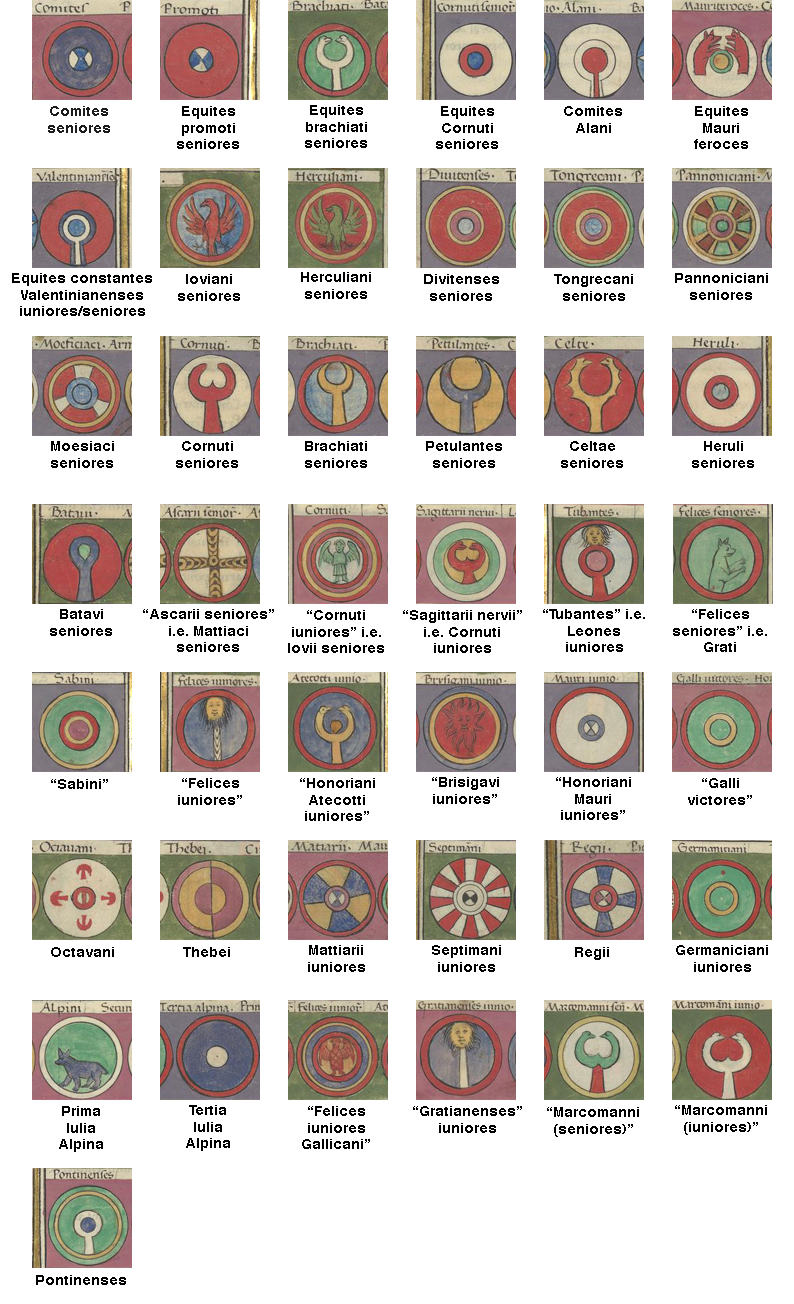
This page last modified: 20 November 2014 (Limitanei provinces added)

|
The following cavalry units are listed as being with the Master of Foot in his Italian command, drawn from those nominally under the command of the Master of Horse (Magister Equitum):
Comites seniores (a vexillationes palatinae unit) along with the following infantry units drawn from his own infantry roster:
Ioviani seniores (a legiones palatina unit) 5 prefects and their limitanei units are also listed as being under the command of the Magister Peditum: In provincia Venetia inferiore:In addition to these military units, 17 prefects of Sarmatian settlers are listed as being stationed in various parts of Italy:Praefectus classis Venetum, at AquileiaeIn provincia Flaminia:Praefectus militum iuniorum Italicorum, at RavennaeIn provincia Liguria: In provincia Italia:Praefectus Sarmatarum gentilium, at Apuliae and CalabriaIn provincia Italia mediterranea: |
No illustrations accompany the listings of the units comprising the Italian military forces. Those shown below are some of the illustrations accompanying the civilian Italian listings.
|
The first two prefects of Sarmatian settlers "in provincia Italia mediterranea" appear to be duplicates of the two "in provincia Italia".
The Equites Cornuti seniores is assigned to both the Italian and the Gallic field commands, while the Equites Cornuti iuniores is unassigned; clearly either the Gallic or the Italian unit is the seniores while the other is the iuniores. There seems no way of conclusively determining which is which. For the sake of simplicity in illustrating their shield patterns below, I will assume that iuniores are in the Gallic army, and the seniores in the Italian army. The Equites constantes Valentinianenses iuniores might well be the same as the Equites constantes Valentinianenses seniores, since this unit is recorded under the Magister Equitum but no equivalent iuniores unit is recorded. Only one of the two Equites Brachiates seniores/iuniores patterns is shown, and there is no conclusive way of telling if it is the correct one (although it is more likely to be that of the seniores).
The Marcomanni seems to be either the Honoriani Marcomanni seniores or the Honoriani Marcomanni iuniores, since both of these units are listed under the Magister Peditum; this means however that the other unit appears to have dropped out of the distribution part of the Notitia somehow.
The Placidi Valentiniaci felices is otherwise unknown. Jones suggested that it was raised by Valentinian III in ca. 420 AD or later, and so not yet entered in the appropriate place in this list, or indeed entered at all in the list of units under his nominal command. However, it seems to me more likely they were simply recently transfered to the Italian command. There is an otherwise unassigned Felices iuniores Gallicani, an auxilia palatina unit listed in the Magister Peditum's list that might be the very same unit; see that unit's page for details.
The Victores seniores are something of a mystery, and as they are not recorded in the list of units under the nominal command of the Magister Peditum, their shield pattern is missing (a unit of Victores was an important unit in Theodosius' command in Britain according to the testimony of Ammianus). Jones identified the Victores seniores with the Victores iuniores Britannicianni (see the discussion of this unit under the Comes Britanniarum), but I am not sure I agree with this analysis. It seems to me the Victores seniores may simply have been destroyed during the time the Notitia was in use, and deleted from parts of the register but not in others.
The shield patterns of these units (save those of the Victores seniores and the Exculcatores seniores, which are missing) that can be positively or plausibly identified are shown below, as taken from the Parisian manuscript, P:

Note that many of the shield patterns listed matching the Magister Peditum's infantry roster are mislabelled; see here for more details. Where the label is clearly wrong, but the correct identity is not clear, I have given the illustrated label in quote marks. Where the label is clearly wrong, and the correct label is also (I believe) reasonably clear, I have given the illustrated label in quote marks, and what I believe is correct pattern for the correct label, which is identified by appending "i.e.".
The positions of the Octavani and Thebei in the Italian list would seem to indicate that they were comitatenses units when the Notitia was first drawn up, only later promoted to the palatine status they are recorded as having under the Magister Peditum's infantry roster. Half of the 12 palatine legions in the western empire are such recently upgraded units.

Return to the Notitia index page.